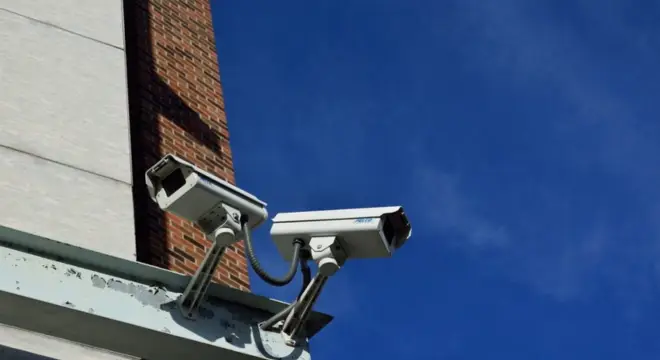Home Security Footage Leads to Indictment in Attempted Kidnapping Case
It started like any normal afternoon. A young girl walking home from her school bus. A quiet neighborhood in Georgetown. Nothing out of the ordinary—until a white van appeared on camera, and everything changed.
As per police reports, a man later identified as a suspect in an attempted luring attempt followed the 10-year-old girl toward her home. What he didn’t know was that a home security camera was watching—and recording.
That footage didn’t just show what happened. It became the key piece of evidence that helped law enforcement move quickly. It showed the girl running. It showed the man chasing. It captured a terrifying moment—and helped prevent what could have been far worse.
This story isn’t just about a single incident. It’s a wake-up call. These moments happen fast, in ordinary places, and often go unseen. But this time, the camera saw it all—and now, the suspect is facing new charges tied to unrelated allegations of unlawful conduct involving a minor.
In this article, I want to break down what happened, why it matters for every parent and neighbor, and how one camera helped protect a child—and a community.
Have you ever thought about what your cameras might catch—or miss? This is the kind of story that makes that question urgent.
The Incident: Details of the Attempted Kidnapping
According to police reports, the incident happened in the Cedar Hills neighborhood of Georgetown, Kentucky. A 10-year-old girl had just stepped off her school bus and was walking home like she did every day. But this time, someone was watching.
A man driving a white van—now identified by police as a suspect—allegedly followed her slowly, then got out and tried to speak with her near her front yard. His behavior, described by authorities as a possible luring attempt, immediately raised red flags.
Thankfully, the girl didn’t hesitate. She ran to her front door and got inside before the man could reach her. The entire sequence—his approach, her escape, and his retreat—was caught on the family’s home security camera.
That footage became a turning point. Police said it gave them a clear image of the suspect and his vehicle, helping them move quickly with their investigation. The video was later shared publicly to help spread awareness and encourage any additional tips from the community.
What makes this even more concerning is that, as per officials, similar reports of a white van seen near children had come in days prior—but without solid evidence, no action could be taken. This time, the footage changed that.
Cameras aren’t just tools to review something after it happens—they can be the reason authorities act fast. If your child ever ends up in danger, having that footage could make all the difference.
Have you ever tested how fast your child could get inside in an emergency? It’s something worth talking about today—not later.
The Suspect: Moises Vergara’s Background and Arrest
Following the release of the home security footage, Georgetown Police moved quickly. Within days, they arrested a man identified as Moises Vergara, age 33, who they say matched the description from the video and witness reports.
According to officials, Vergara was taken into custody in October 2024. At the time of his arrest, he was officially named a suspect in the attempted luring of the 10-year-old girl. Investigators also noted that multiple tips had come in from residents who had seen a white van behaving suspiciously in nearby neighborhoods. Those leads helped connect the dots.
This wasn’t the first time authorities had received concerns about similar behavior. While no formal charges had been filed in those earlier instances, police say Vergara is now being investigated for possible connections to other reports involving minors. All of those cases remain under review.
At this stage, it’s important to note: Vergara has not been convicted of any crime. He remains a suspect and is facing multiple allegations, some of which now involve separate legal proceedings related to other incidents.
One arrest doesn’t mean the danger disappears. Often, these cases highlight ongoing patterns—and they rely on local vigilance to bring attention to suspicious behavior early. This is why reporting what you see, even if it feels small, truly matters.
Have you ever noticed something off but weren’t sure whether to call it in? This is a reminder: when it comes to a child’s safety, say something—even if you’re not certain.
New Developments: Indictment on Unrelated Allegations Involving a Minor

As the investigation into the attempted luring incident continues, new legal developments have come to light involving the same suspect.
In May 2025, a Scott County grand jury indicted the man on a separate case unrelated to the Georgetown incident. According to reports, he is now facing charges related to inappropriate contact involving a minor under the age of 12. Authorities have emphasized that this is a different matter, but it has raised additional concerns about the suspect’s past behavior.
Due to the sensitive nature of the case, officials have not released further details to protect the privacy of the individuals involved. However, police say the charge reflects serious concerns and is being treated with the utmost priority.
The suspect is scheduled to appear in court on June 6, 2025, where both cases may begin to move forward on separate legal tracks.
When separate allegations begin to surface, it often points to a larger pattern that may have gone unnoticed for too long. These moments are when it becomes even more critical for communities to stay alert, report concerns, and take signs seriously.
Community Response and Safety Measures
When the video of the attempted luring surfaced, it didn’t just alarm Georgetown—it mobilized it.
Neighbors began sharing the footage across Facebook groups, warning others to stay alert. Local parents walked their kids to and from the bus stop the next day, many of them saying they’d never take that short walk for granted again.
Community leaders and law enforcement responded quickly. Georgetown Police increased patrols near schools and residential areas. School staff were briefed to keep an extra eye during pick-up hours. And the message was clear: don’t dismiss suspicious behavior—report it.
The local conversation also shifted toward prevention. Officials started encouraging more families to install home cameras, or at least register their existing ones with neighborhood watch programs. Some residents even coordinated to place doorbell cameras in shared areas like bus stop corners.
These weren’t dramatic changes. They were practical, simple steps—and they made people feel less helpless.
Safety isn’t just a police issue—it’s a community effort. And often, the first warning signs don’t show up on official reports. They show up on sidewalks, in passing conversations, or in someone’s gut feeling.
What small step could you take this week to make your neighborhood safer? Whether it’s a camera, a conversation, or just looking up during drop-off—you’re part of the system that keeps others safe.
For another perspective on how quickly lives can be changed by senseless violence, read about the Colorado mom who was tragically killed in her home.
The Role of Surveillance Technology in Crime Prevention

This entire case may have unfolded differently—maybe even gone unnoticed—if that family’s home didn’t have a security camera facing the street.
The moment the suspect stepped out of the white van was recorded. The girl’s sprint to safety was recorded. His retreat was recorded. And that single clip did more than tell a story—it gave law enforcement everything they needed to act fast.
For police, having visual evidence meant they weren’t just relying on a shaken child’s memory or secondhand witness reports. They had something concrete: time stamps, vehicle description, suspect behavior. That’s what turned a “possible attempt” into a chargeable case.
And it’s not just about this one family. Across the country, doorbell cams and home surveillance systems are helping solve package thefts, break-ins, missing persons cases—and yes, incidents involving children.
Still, some people hesitate. They worry about privacy, cost, or whether it’s “paranoid” to record everything. But what this story shows is that even one camera can shift the outcome. It’s not about catching people—it’s about protecting your space, and your people, before something happens.
If you’ve ever thought, “Nothing like that would happen here,” think again. That’s what most people believe—until it does.
Do you know what your camera sees when your kid walks up to the door? If not, it might be time to check.
Legal Perspectives: Understanding the Charges and Potential Outcomes
When a case involves a child, even the legal language can feel heavy. But it’s important to understand what’s really happening—because that clarity helps us talk about it, prepare for it, and take it seriously.
In this case, the suspect is facing two separate sets of allegations:
- One tied to the attempted luring of a 10-year-old girl, as seen on home security footage.
- Another, unrelated charge involving unlawful conduct with a minor under 12, brought forward by a grand jury.
In Kentucky, charges like “attempted kidnapping” or “first-degree sexual abuse” (as listed in court records) carry serious weight. If convicted, they can lead to significant prison time, mandatory registration as a sex offender, and lifelong restrictions.
But it’s also important to say this: at this point, these are still allegations. The suspect is legally presumed innocent until proven guilty in a court of law. That’s not just a technicality—it’s a foundation of the justice system.
Still, these charges signal that law enforcement believes there is enough evidence to move forward. Prosecutors now have to prove their case, and the defense will have the chance to respond. The upcoming court date on June 6, 2025, will be the next key moment in this process.
Understanding how these cases move through the system helps us stay informed—not just emotionally reactive. It also reminds us why evidence like security footage, witness statements, and community reports are so crucial.
Conclusion
This wasn’t just a near-miss. It was a reminder—of how quickly danger can show up, and how powerful it is when a community refuses to look away.
One girl’s instincts. One family’s security camera. One neighborhood that paid attention. That’s what turned a silent threat into a public case—and possibly prevented something much worse.
But here’s the truth: not every family has a camera. Not every child knows what to do. And not every adult follows their gut when something seems off.
If we want to keep our communities safe, it has to be all of us—watching, speaking up, and preparing our kids for the world as it is, not as we wish it were.
Disclaimer: All details are based on official reports available as of May 2025. The suspect is presumed innocent unless proven guilty in court. This article is for public awareness and safety education only.


